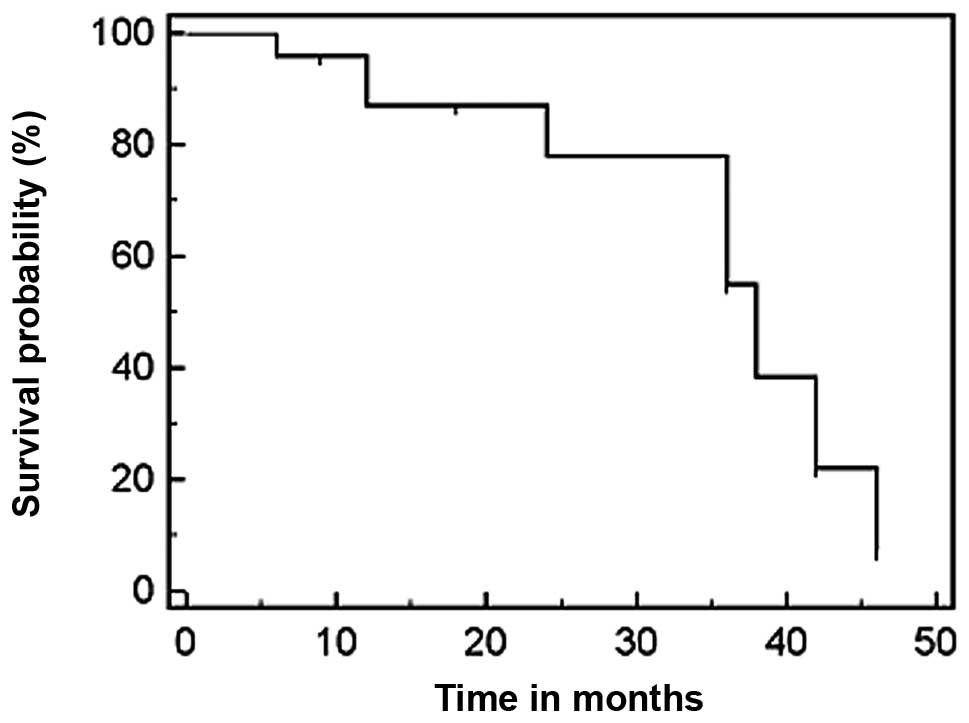|
1.
|
Spiro SG and Silvestri GA: One hundred
years of lung cancer. Am J Respir Crit Care Med. 172:523–529.
2005.PubMed/NCBI
|
|
2.
|
Collins LG, Haines C, Perkel R and Enck
RE: Lung cancer: diagnosis and management. Am Fam Physician.
75:56–63. 2007.
|
|
3.
|
d’Amato TA, Galloway M, Szydlowski G, Chen
A and Landreneau RJ: Intraoperative brachytherapy following
thoracoscopic wedge resection of stage I lung cancer. Chest.
114:1112–1115. 1998.PubMed/NCBI
|
|
4.
|
Chen A, Galloway M, Landreneau R, et al:
Intraoperative 125I brachytherapy for high-risk stage I
non-small cell lung carcinoma. Int J Radiat Oncol Biol Phys.
44:1057–1063. 1999.
|
|
5.
|
Lee W, Daly BD, DiPetrillo TA, Morelli DM,
Neuschatz AC, Morr J and Rivard MJ: Limited resection for non-small
cell lung cancer: observed local control with implantation of I-125
brachy-therapy seeds. Ann Thorac Surg. 75:237–242. 2003. View Article : Google Scholar : PubMed/NCBI
|
|
6.
|
Pisch J, Belsley SJ, Ashton R, Wang L,
Woode R and Connery C: Placement of 125I implants with
the da Vinci robotic system after video-assisted thoracoscopic
wedge resection: a feasibility study. Int J Radiat Oncol Biol Phys.
60:928–932. 2004.
|
|
7.
|
Zhang FJ, Li CX, Wu PH, Wu YX, Jiao DC,
Liu J and Li YL: CT guided radiazctive 125I seed
implantation in treating localized advanced pulmonary carcinoma.
Zhonghua Yi Xue Za Zhi. 87:3272–3275. 2007.(In Chinese).
|
|
8.
|
Nag S, Beyer D, Friedland J, Grimm P and
Nath R: American Brachytherapy Society (ABS) recommendations for
transperineal permanent brachytherapy of prostate cancer. Int J
Radiat Oncol Biol Phys. 44:789–799. 1999. View Article : Google Scholar : PubMed/NCBI
|
|
9.
|
Eisenhauer EA, Therasse P, Bogaerts J, et
al: New response evaluation criteria in solid tumors: revised
RECIST guideline (version 1.1). Eur J Cancer. 45:228–247. 2009.
View Article : Google Scholar
|
|
10.
|
Das M, Abdelmaksoud MH, Loo BW Jr and
Kothary N: Alternatives to surgery for early stage non-small cell
lung cancer-ready for prime time? Curr Treat Options Oncol.
11:24–35. 2010. View Article : Google Scholar : PubMed/NCBI
|
|
11.
|
Schneider T, Reuss D, Warth A, et al: The
efficacy of bipolar and multipolar radiofrequency ablation of lung
neoplasms - results of an ablate and resect study. Eur J
Cardiothoracic Surg. 39:968–973. 2011. View Article : Google Scholar : PubMed/NCBI
|
|
12.
|
Abbas G, Schuchert MJ, Pennathur A,
Gilbert S and Luketich JD: Ablative treatments for lung tumors:
radiofrequency ablation, stereotactic radiosurgery, and microwave
ablation. Thorac Surg Clin. 17:261–271. 2007. View Article : Google Scholar : PubMed/NCBI
|
|
13.
|
Nguyen CL, Scott WJ, Young NA, Rader T,
Giles LR and Goldberg M: Radiofrequency ablation of primary lung
cancer: results from an ablate and resect pilot study. Chest.
128:3507–3511. 2005.PubMed/NCBI
|
|
14.
|
Ambrogi MC, Lucchi M, Dini P, et al:
Percutaneous radiofrequency ablation of lung tumours: results in
the mid-term. Eur J Cardiothorac Surg. 30:177–183. 2006. View Article : Google Scholar : PubMed/NCBI
|
|
15.
|
Baumann P, Nyman J, Lax I, et al: Factors
important for efficacy of stereotactic body radiotherapy of
medically inoperable stage I lung cancer. A retrospective analysis
of patients treated in the Nordic countries. Acta Oncol.
45:787–795. 2006. View Article : Google Scholar
|
|
16.
|
Beitler JJ, Badine EA, El-Sayah D, et al:
Stereotactic body radiation therapy for nonmetastatic lung cancer:
an analysis of 75 patients treated over 5 years. Int J Radiat Oncol
Biol Phys. 65:100–106. 2006.PubMed/NCBI
|
|
17.
|
Zhang J, Yang F, Li B, et al: Which is the
optimal biologically effective dose of stereotactic body
radiotherapy for stage I non-small-cell lung cancer? A
meta-analysis. Int J Radiat Oncol Biol Phys. 81:e305–e316. 2011.
View Article : Google Scholar : PubMed/NCBI
|
|
18.
|
Fakiris AJ, McGarry RC, Yiannoutsos CT,
Papiez L, Williams M, Henderson MA and Timmerman R: Stereotactic
body radiation therapy for early-stage non-small-cell lung
carcinoma: four-year results of a prospective phase II study. Int J
Radiat Oncol Biol Phys. 75:677–682. 2009.PubMed/NCBI
|
|
19.
|
Guckenberger M, Heilman K, Wulf J, Mueller
G, Beckmann G and Flentje M: Pulmonary injury and tumor response
after stereo-tactic body radiotherapy (SBRT): results of a serial
follow-up CT study. Radiother Oncol. 85:435–442. 2007. View Article : Google Scholar : PubMed/NCBI
|
|
20.
|
Hoppe BS, Laser B, Kowalski AV, et al:
Acute skin toxicity following stereotactic body radiation therapy
for stage I non-small-cell lung cancer: who’s at risk? Int J Radiat
Oncol Biol Phys. 72:1283–1286. 2008.PubMed/NCBI
|
|
21.
|
Ricardi U, Filippi AR, Guarneri A, et al:
Stereotactic body radiation therapy for early stage non-small cell
lung cancer: results of a prospective trial. Lung Cancer. 68:72–77.
2010. View Article : Google Scholar : PubMed/NCBI
|
|
22.
|
Mutyala S, Stewart A, Khan AJ, Cormack RA,
O’Farrell D, Sugarbaker D and Devlin PM: Permanent iodine-125
interstitial planar seed brachytherapy for close or positive
margins for thoracic malignancies. Int J Radiat Oncol Biol Phys.
76:1114–1120. 2010. View Article : Google Scholar : PubMed/NCBI
|
|
23.
|
Templeton PA, White CS, Protopapas Z, et
al: Real-time continuous imaging CT guidance for lung biopsy.
Radiology. 201:2701996.
|
|
24.
|
Slater JD, Ellerbroek NA, Barkley HT,
Mountain C, Oswald MJ, Roth JA and Pepers LJ: Radiation therapy
following resection of non-small cell bronchogenic carcinoma. Int J
Radiat Oncol Biol Phys. 20:945–951. 1991. View Article : Google Scholar : PubMed/NCBI
|
|
25.
|
Choi NC and Kanarek DJ: Toxixity of
thoracic radiotherapy on pulmonary function in lung cancer. Lung
Cancer. 10:S219–S230. 1994. View Article : Google Scholar : PubMed/NCBI
|

















